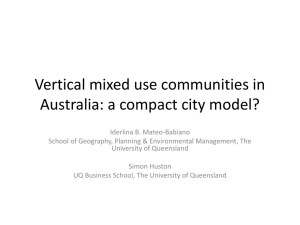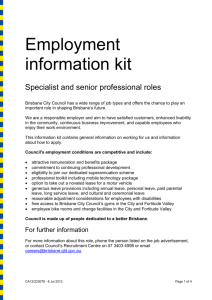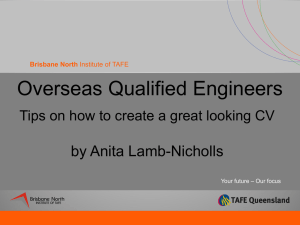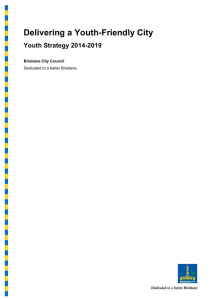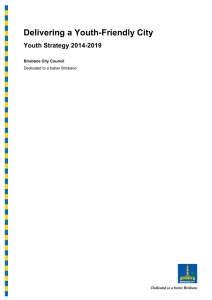Lord Mayor`s Brisbane Economic Snapshot
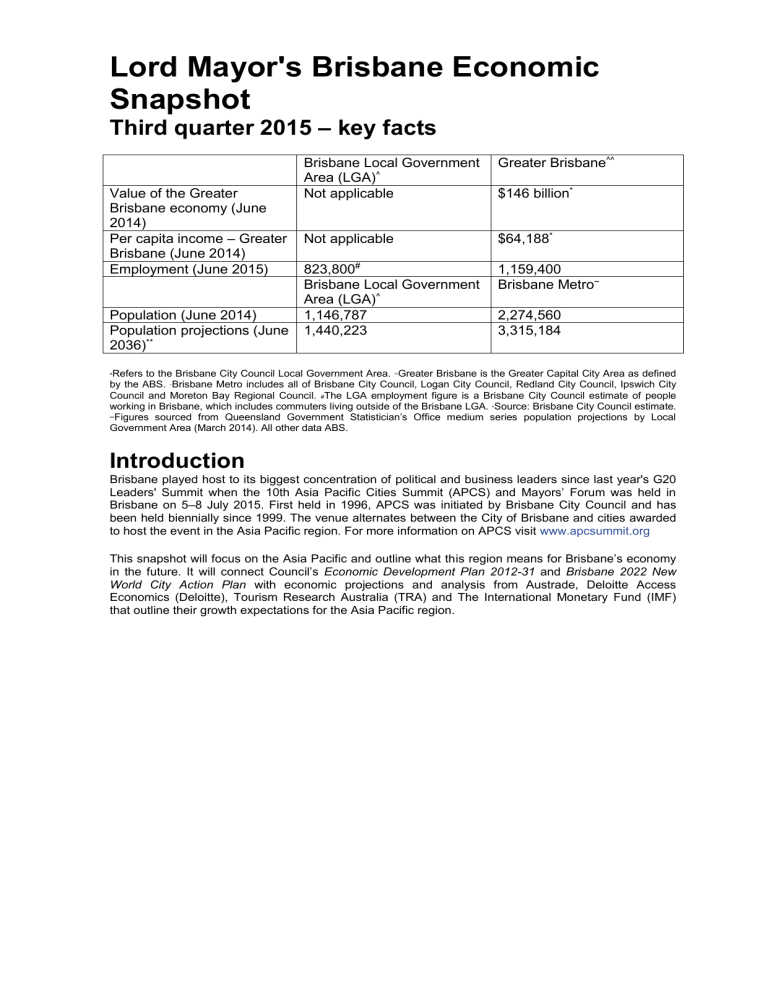
Lord Mayor's Brisbane Economic
Snapshot
Third quarter 2015 – key facts
Value of the Greater
Brisbane economy (June
2014)
Per capita income – Greater
Brisbane (June 2014)
Employment (June 2015)
Brisbane Local Government
Area (LGA)
^
Not applicable
Not applicable
Greater Brisbane
$146 billion
$64,188
*
*
^^
Population (June 2014)
Population projections (June
2036)
**
823,800
#
Brisbane Local Government
Area (LGA)
^
1,146,787
1,440,223
1,159,400
Brisbane Metro
2,274,560
3,315,184
~
^
Refers to the Brisbane City Council Local Government Area.
^^
Greater Brisbane is the Greater Capital City Area as defined by the ABS.
~
Brisbane Metro includes all of Brisbane City Council, Logan City Council, Redland City Council, Ipswich City
Council and Moreton Bay Regional Council.
#
The LGA employment figure is a Brisbane City Council estimate of people working in Brisbane, which includes commuters living outside of the Brisbane LGA.
*
Source: Brisbane City Council estimate.
**
Figures sourced from Queensland Government Statistician’s Office medium series population projections by Local
Government Area (March 2014). All other data ABS.
Introduction
Brisbane played host to its biggest concentration of political and business leaders since last year's G20
Leaders' Summit when the 10th Asia Pacific Cities Summit (APCS) and Mayors’ Forum was held in
Brisbane on 5
–8 July 2015. First held in 1996, APCS was initiated by Brisbane City Council and has been held biennially since 1999. The venue alternates between the City of Brisbane and cities awarded to host the event in the Asia Pacific region. For more information on APCS visit www.apcsummit.org
This snapshot will focus on the Asia Pacific and outline what th is region means for Brisbane’s economy in the future. It will connect Council’s
Economic Development Plan 2012-31 and Brisbane 2022 New
World City Action Plan with economic projections and analysis from Austrade, Deloitte Access
Economics (Deloitte), Tourism Research Australia (TRA) and The International Monetary Fund (IMF) that outline their growth expectations for the Asia Pacific region.
Figure 1 - Asia Pacific region as defined for the
2015 Asia Pacific Cities Summit and Mayors' Forum 1
The Economies of the Asia Pacific Region
The Asia Pacific region contains more than half of the world’s population and will be the major contributor to the global economy with extensive trading and collaboration with the rest of the world. The region is highly dynamic, with both rapid population and economic growth and urbanisation.
Of the 20 largest economies in the world, which account for 80.1% of total world Gross Domestic
Product, eight, including Australia, are in the Asia Pacific region
2
. In 2000 the Asia Pacific region accounted for less than 30% of world output. By 2014 this had risen to almost 40%
3
.
The IMF forecasts the economies of the Asia Pacific region will remain the global growth leader and views them as ‘stable and robust’. The region accounted for nearly two-thirds of global growth in 2014.
Regional economic growth is expected to be 5.6% in 2015 and 5.5% in 2016
3
.
What growth in the Asia Pacific economies means for Australia
Austrade notes that the productivity levels of 16 out of 20 Australian industries rate above the average productivity of global competitors in the same sector and that Australia is performing more than 20% above this global average in five key growth sectors including gas, international education, other education and training, health and tourism, and more than 40% in agribusiness, oil and mining
2
.
Figure 2
– Projected annual global industry output growth, 2013-33 4
The Deloitte report Positioning for prosperity? Catching the next wave
4 describes three economic trends
– the current growth wave, the next five growth waves and 19 future growth waves. The current growth wave is the mining sector. The next growth waves are agribusiness, gas, tourism, international education and wealth management. These industry sectors align closely with the strengths of the
Brisbane and South East Queensland economy.
Where Brisbane fits in
Brisbane has the industries, productivity, skilled workforce and experience to become a key service and knowledge centre to support the economic growth of the Asia Pacific region. The current low Australian dollar will benefit trade-exposed sectors, such as agriculture, mining, manufacturing including advanced manufacturing, tourism, education, and the finance and business services sectors, all of which are represented in the Greater Brisbane economy. Greater Brisbane is also well positioned to take advantage of the growth predicted for the agribusiness, gas, tourism, international and wealth management sectors. The Positioning for prosperity? Catching the next wave report suggests that these growth sectors have the collective potential to overtake the mining sector and sustain our continued economic growth
4
.
Similarly there are many opportunities, such as information and communication technologies, food processing and medical research in future growth waves where Brisbane has an advantage. The
Greater Brisbane economy has an appropriately skilled workforce and a small and medium enterprise
(SME) business sector with the skills and knowledge to compete globally. The role out of high speed broadband allows an increasingly diverse range of services to be provided in a digital format, shifting the balance of the economy to service-oriented sectors.
This creates the opportunity for Brisbane’s services industries to access international customers through digital delivery methods and for new types of highvalue services to be developed and exported.
Brisbane's other advantages include our proximity to the world’s fastest-growing markets in Asia, the use of
English, the world’s business language, our climate and our well-understood tax and regulatory regimes.
Spotlight on Tourism as an export industry
Leisure travel continues to drive record tourism numbers in Brisbane for the year to March 2015.
Tourism Research Australia’s latest International Visitor Survey shows that Brisbane has, for the first time, welcomed one million international visitors, with tourists pumping more than $1 billion into our economy
5
. The figures, which are a 7% increase on the previous year, were the highlight of an outstanding 12 months for Queensland’s tourism, which showed growth in every region.
The potential of Australia’s tourism industry was also highlighted in the recent Deloitte report. The report identified tourism as one of Australia’s five super growth industries capable of collectively delivering an additional $250 billion to the Australian economy over the next 20 years.
The increased interest by international visitors in Brisbane is a direct result of recent high profile international events, such as last year’s G20 Leaders' Summit and the recent APCS. It also recognises
Brisbane’s blossoming arts, bar and dining scenes. International tourism increased across all sectors including holiday, those visiting friends and family, and business-related travel.
Brisbane’s top international visitor markets are China, New Zealand, the United Kingdom, Japan and the
United States of America.
References
1
Brisbane City Council, Asia Pacific Cities Summit
– Defining Asia Pacific,
Brisbane, 2015, viewed 28
August 2015, www.apcsummit.org
2
Australian Trade Commission, Digital Benchmark Report
– Growth,
Australian Government, Australia,
2015, viewed 27 August 2015, www.austrade.gov.au
3
International Monetary Fund, Regional Economic Outlook for Asia and Pacific, International Monetary
Fund, Washington DC, 2015.
4
Deloitte Australia Positioning for Prosperity? Catching the next wave, Australia, 2015, viewed 28
August 2015, www2.deloitte.com/au/en.html
5
Tourism Research Australia, International Visitor Survey, Queensland, 2015, viewed 27 August
2015, https://d2psoxjwp45svd.cloudfront.net/~/media/DBBBB98FB1524E3E9B48967AFBAC649B.ashx?vs=1& d=20150728T132017


